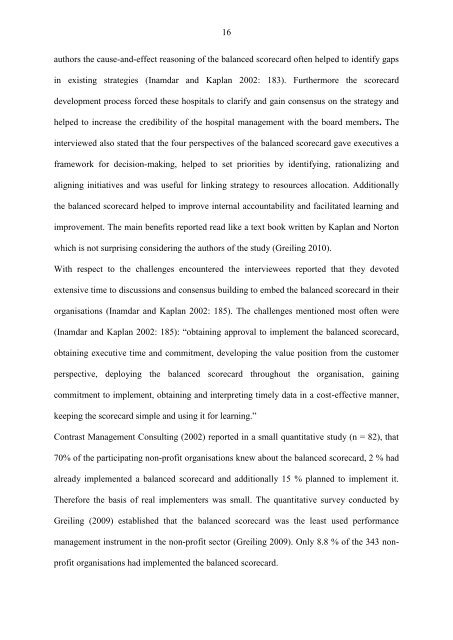Strategic responses to Performance Measurement in Nonprofit ...
Strategic responses to Performance Measurement in Nonprofit ...
Strategic responses to Performance Measurement in Nonprofit ...
Create successful ePaper yourself
Turn your PDF publications into a flip-book with our unique Google optimized e-Paper software.
16<br />
authors the cause-and-effect reason<strong>in</strong>g of the balanced scorecard often helped <strong>to</strong> identify gaps<br />
<strong>in</strong> exist<strong>in</strong>g strategies (Inamdar and Kaplan 2002: 183). Furthermore the scorecard<br />
development process forced these hospitals <strong>to</strong> clarify and ga<strong>in</strong> consensus on the strategy and<br />
helped <strong>to</strong> <strong>in</strong>crease the credibility of the hospital management with the board members. The<br />
<strong>in</strong>terviewed also stated that the four perspectives of the balanced scorecard gave executives a<br />
framework for decision-mak<strong>in</strong>g, helped <strong>to</strong> set priorities by identify<strong>in</strong>g, rationaliz<strong>in</strong>g and<br />
align<strong>in</strong>g <strong>in</strong>itiatives and was useful for l<strong>in</strong>k<strong>in</strong>g strategy <strong>to</strong> resources allocation. Additionally<br />
the balanced scorecard helped <strong>to</strong> improve <strong>in</strong>ternal accountability and facilitated learn<strong>in</strong>g and<br />
improvement. The ma<strong>in</strong> benefits reported read like a text book written by Kaplan and Nor<strong>to</strong>n<br />
which is not surpris<strong>in</strong>g consider<strong>in</strong>g the authors of the study (Greil<strong>in</strong>g 2010).<br />
With respect <strong>to</strong> the challenges encountered the <strong>in</strong>terviewees reported that they devoted<br />
extensive time <strong>to</strong> discussions and consensus build<strong>in</strong>g <strong>to</strong> embed the balanced scorecard <strong>in</strong> their<br />
organisations (Inamdar and Kaplan 2002: 185). The challenges mentioned most often were<br />
(Inamdar and Kaplan 2002: 185): “obta<strong>in</strong><strong>in</strong>g approval <strong>to</strong> implement the balanced scorecard,<br />
obta<strong>in</strong><strong>in</strong>g executive time and commitment, develop<strong>in</strong>g the value position from the cus<strong>to</strong>mer<br />
perspective, deploy<strong>in</strong>g the balanced scorecard throughout the organisation, ga<strong>in</strong><strong>in</strong>g<br />
commitment <strong>to</strong> implement, obta<strong>in</strong><strong>in</strong>g and <strong>in</strong>terpret<strong>in</strong>g timely data <strong>in</strong> a cost-effective manner,<br />
keep<strong>in</strong>g the scorecard simple and us<strong>in</strong>g it for learn<strong>in</strong>g.”<br />
Contrast Management Consult<strong>in</strong>g (2002) reported <strong>in</strong> a small quantitative study (n = 82), that<br />
70% of the participat<strong>in</strong>g non-profit organisations knew about the balanced scorecard, 2 % had<br />
already implemented a balanced scorecard and additionally 15 % planned <strong>to</strong> implement it.<br />
Therefore the basis of real implementers was small. The quantitative survey conducted by<br />
Greil<strong>in</strong>g (2009) established that the balanced scorecard was the least used performance<br />
management <strong>in</strong>strument <strong>in</strong> the non-profit sec<strong>to</strong>r (Greil<strong>in</strong>g 2009). Only 8.8 % of the 343 non-<br />
profit organisations had implemented the balanced scorecard.
















